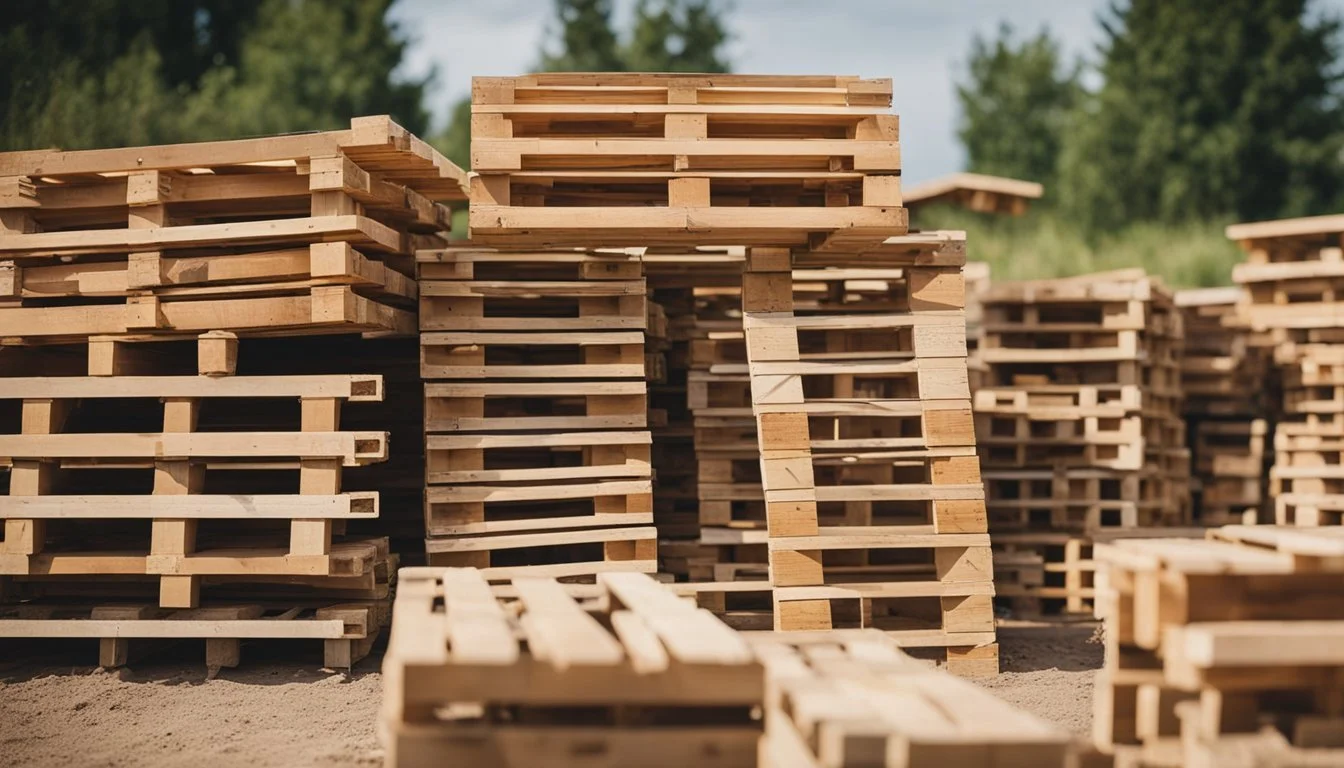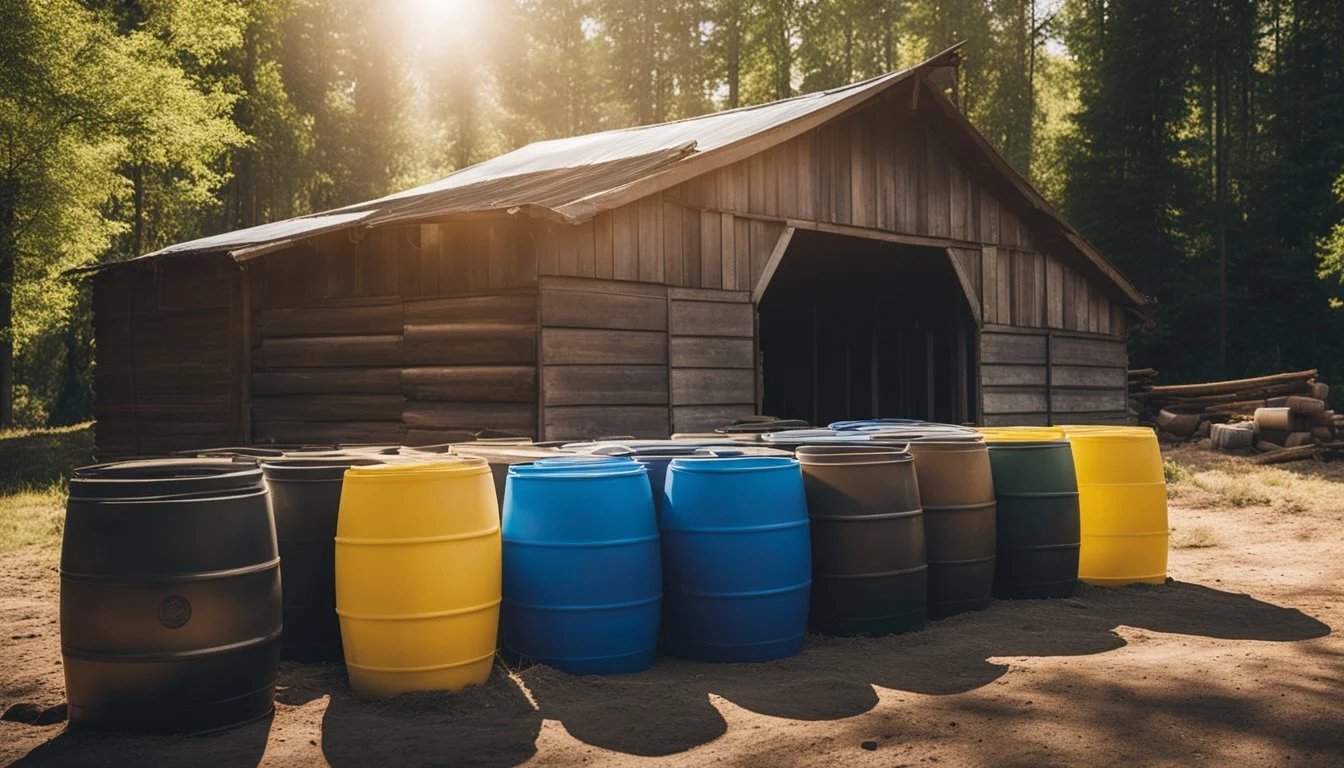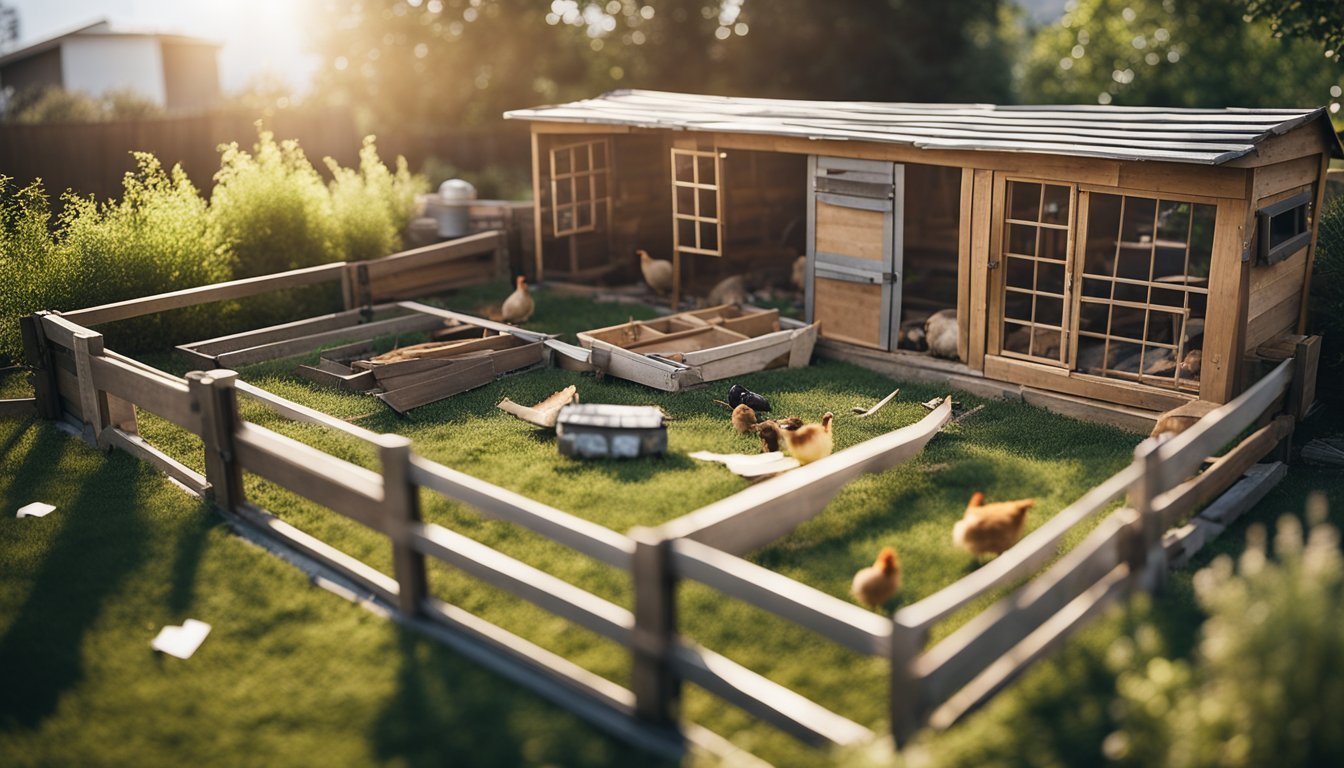10 Steps to Building a Chicken Coop from Recycled Materials
Eco-Friendly Guide
Building a chicken coop from recycled materials is a practical and sustainable way to keep chickens while being mindful of the environment. By reusing items that might otherwise end up in a landfill, individuals can create a functional and unique coop that meets their needs. This guide provides essential steps to construct a chicken coop using various recycled materials, ensuring both cost-effectiveness and environmental friendliness.
Whether you are a seasoned builder or a novice interested in sustainable agriculture, this step-by-step approach can help you set up a coop that is both durable and comfortable for your chickens. Through thoughtful planning and careful selection of materials, anyone can successfully create a safe and efficient home for their poultry.
1) Gather Pallets for Frame
To start building a chicken coop from recycled materials, the first step is to gather pallets. Pallets are commonly available at warehouses, home improvement stores, and industrial sites. They are often given away for free or can be purchased at a low cost.
Focus on finding sturdy, undamaged pallets. Look for those made of hardwood, as they will provide a strong frame for the coop. Avoid pallets that are cracked, broken, or treated with harmful chemicals, as these may be unsafe for chickens.
Inspect each pallet for nails, splinters, and sharp edges. Remove any protruding nails and sand down rough spots to ensure safety when handling. Pallets come in various sizes, so choose those that will fit together well and suit the dimensions of your planned coop.
Gather enough pallets to create the entire frame of the coop. Typically, eight to ten pallets should suffice, depending on the size of the structure. Store your collected pallets in a dry place until you are ready to begin assembly.
2) Collect Recycled Plywood
Recycled plywood is a versatile and cost-effective material for building a chicken coop. It's strong, durable, and often readily available. Look for sources of discarded plywood in various places.
Check local recycling centers and online marketplaces like Craigslist. Construction sites can also be a valuable resource. Ensure that the plywood is in good condition without significant rot or damage.
Cleaning and disinfecting the plywood is an essential step. This ensures the health and well-being of your chickens. Use a mild detergent and water to remove dirt and debris. Allow it to dry completely before use.
By using recycled plywood, you not only save money but also reduce waste. This aligns with sustainable building practices. It’s an excellent choice for any eco-conscious chicken keeper.
3) Find Old Windows
Old windows can be a valuable addition to a chicken coop. They provide natural light and ventilation, which are essential for the health of the chickens.
Reclaimed windows can be sourced from old homes, barns, or salvage yards. This can also be an eco-friendly and cost-effective option.
Ensure the windows are free of cracks and sharp edges. If the windows have old paint, checking for lead is critical for safety.
Measure the windows to ensure they fit well into the coop's design. Proper fitting is crucial to prevent drafts that could harm the chickens.
Finally, securely install the windows to avoid gaps and make sure they can be easily opened and closed for ventilation control. This will help in maintaining a consistent and healthy environment for the chickens.
4) Use Scrap Metal for Roof
A durable and weather-resistant roof is vital for any chicken coop. Scrap metal, such as corrugated tin or galvanized metal sheets, can be used effectively.
First, measure the roof area to determine the amount of scrap metal required. Ensure the pieces are large enough to cover the space without excessive overlap.
Clean and sanitize the scrap metal to ensure it is free from rust and contaminants. This step is important to protect the health of the chickens.
When attaching the metal sheets, start from the bottom edge of the roof and work your way upwards. Overlap each sheet slightly to prevent water from seeping through.
Secure the metal sheets using screws with rubber washers. The washers will help create a watertight seal, further protecting the coop’s interior from moisture.
Using scrap metal for the roof not only saves money but also extends the life of materials that might otherwise go to waste. This choice supports sustainability while providing reliable shelter for the flock.
5) Repurpose Wooden Doors
Old wooden doors can serve as excellent materials for building a chicken coop. They are typically sturdy and can be easily adapted to fit various parts of the coop structure. Using them can save money and add a unique touch to the design.
One way to use wooden doors is as walls for the coop. By placing the doors vertically, you create durable barriers that help keep predators out and chickens safe inside. Make sure to secure them tightly to the frame.
Wooden doors can also function as doors for the coop itself. You might need to cut them to size, but they provide solid, easy-to-clean entrances. Adding a simple latch ensures that the doors stay closed securely.
To create ventilation, consider leaving some panels open or replacing sections with wire mesh. This helps maintain airflow, keeping the chickens healthy. Reusing door panels in this way maximizes both functionality and aesthetics.
In some cases, you can use old cabinet doors or shutters as nesting boxes or roosting perches. These smaller doors can be easily attached inside the coop and provide comfortable, familiar spaces for the chickens. Repurposing doors in these creative ways ensures nothing goes to waste.
6) Locate Chicken Wire
Chicken wire is an essential part of building a secure chicken coop. It keeps predators out and chickens safely inside. When sourcing chicken wire, consider both new and salvaged materials.
Recycled sources such as old fencing or leftover wire from other projects can be valuable. Local farms or online marketplaces often have surplus wire available.
If using recycled chicken wire, ensure it is free of rust and damage. Checking for holes or weak spots prevents future issues.
Hardware stores and home improvement centers carry new chicken wire in various sizes and gauges. Choose the appropriate gauge depending on the predators in your area.
Some suppliers may offer bulk discounts which can be cost-effective for larger projects. By exploring both new and recycled options, builders can find reliable chicken wire that suits their needs.
7) Utilize Used Fencing Posts
Used fencing posts can form a sturdy foundation for your chicken coop. They are often made from durable materials like wood or metal, which can withstand various weather conditions.
Begin by sourcing these posts from old fences or construction sites. Ensure that they are free from rot or significant damage before use.
These posts can be driven into the ground to form the corners of the coop. Secure them firmly, as they will support the weight of the structure.
Attach horizontal beams to the posts to create the framework. This step will add rigidity and stability to the coop.
By recycling old materials, not only is the cost reduced, but it's also an environmentally friendly choice.
8) Source Reclaimed Lumber
Reclaimed lumber is an excellent material for building a chicken coop. It is cost-effective and environmentally friendly.
Look for old buildings, barns, or warehouses that are being dismantled. Many times, owners are willing to give away or sell old wood at a low cost.
Visit local scrap yards or salvage stores. They often have a variety of wood pieces that can be repurposed for your coop.
Keep an eye on classified ads or online marketplaces. Sellers may list old wood from home renovation projects that can be used.
Make sure to check the quality of the reclaimed wood. Ensure it is free from rot, insects, and excessive wear.
Using reclaimed lumber for your chicken coop adds character and charm. It also helps reduce waste, making it a sustainable choice.
9) Acquire Plastic Barrels
Plastic barrels are versatile materials for constructing chicken coops. These barrels provide a durable and weather-resistant option for creating a safe environment for chickens.
To start, look for used plastic barrels from local sources. Factories, farms, and even online marketplaces often have them available. Ensure they previously held non-toxic substances to avoid harming your chickens.
Clean the barrels thoroughly. Disinfecting is crucial, as residual substances can pose health risks. Use a solution of water and a mild bleach or vinegar mix to sanitize them properly.
Cutting the barrels to form entrances and ventilation requires basic tools like a jigsaw or handsaw. These modifications help maintain airflow and accessibility for cleaning.
Position plastic barrels in a way that allows easy integration with other recycled materials. This flexibility offers a customized coop layout that fits your space and needs.
10) Collect Old Hinges
Old hinges are an essential component when building a chicken coop from recycled materials. They provide the necessary support and function for doors and access points. The durability of old hinges often matches or exceeds that of new ones.
Look for discarded furniture, gates, or cabinets in your local area. Places like scrap yards and construction sites are great resources. Sometimes, online marketplaces such as Craigslist or Freecycle offer free or low-cost options.
Ensure the hinges are in good condition. Rust or damage can affect their performance. Cleaning and possibly repainting them can extend their lifespan. Also, check if the screws are intact or if you'll need replacements.
It’s important to collect enough hinges for your project. Measure the required quantity based on your coop design. Having a few extra hinges is always a good idea in case some don't fit properly.
Reusing old hinges not only saves money but also contributes to reducing waste. With careful selection and preparation, old hinges can effectively serve their purpose in your recycled-material chicken coop.
Selecting Suitable Recycled Materials
Choosing the right recycled materials for your chicken coop ensures its durability and safety. Key factors include the longevity of materials and their cleanliness to prevent health issues.
Assessing Material Durability
To build a long-lasting chicken coop, consider the durability of the recycled materials. Materials such as wood, metal, and plastic can provide significant structural support. Cedar and redwood, for example, are known for their resistance to rot, making them ideal for outdoor use. Metal, like galvanized steel, can withstand harsh weather conditions and resist rusting over time.
When selecting wood, check for signs of rot, insect damage, or warping. A sturdy frame is crucial for maintaining the structure's integrity. Plastic barrels can be repurposed into nesting boxes but ensure they are sturdy and crack-free. Rebar and metal pipes can be used for framing, offering longevity and strength.
Ensuring Safety and Cleanliness
The safety and hygiene of the materials used in your coop are paramount. Recycled materials must be free of chemicals, toxins, or sharp edges. Thoroughly inspect each piece for potential hazards like protruding nails or splinters that could harm your chickens.
Disinfecting materials before usage is essential. Clean wood, metal, and plastic items with a solution of water and a mild bleach to remove any contaminants. Ensuring cleanliness helps prevent the spread of diseases. If using previously painted materials, ensure the paint is non-toxic and lead-free.
Check that all materials are food-safe, particularly items like plastic or metal which may have housed chemicals in their previous life. Safety considerations are not just for the chickens but also to ensure a sustainable and healthy coop environment.
Design and Planning
Good planning is essential to creating a functional and sustainable chicken coop. This involves drafting a basic blueprint and calculating the appropriate space for your flock.
Sketching a Basic Blueprint
A clear and precise sketch serves as the foundation for your chicken coop. By outlining the dimensions and placement of each component, you ensure efficient use of recycled materials.
Start by identifying the main sections: the coop area, nesting boxes, perches, and the run.
Tools needed:
Pencil
Graph paper
Ruler
Allocate specific spaces for food, water containers, and ventilation. Including windows and vents in the sketch provides essential airflow, reducing moisture and preventing respiratory issues.
Consider accessibility for cleaning and collecting eggs. Easy access for maintenance saves time and effort in the long run.
Calculating Required Space
Proper spacing ensures the health and productivity of your chickens. Standard recommendations suggest:
Coop space: 3-4 square feet per chicken
Run space: 8-10 square feet per chicken
Adequate space avoids overcrowding, which can lead to stress and disease. For instance, a flock of six chickens should have an 18-24 square foot coop and a 48-60 square foot run.
Factor in extra space for additional chickens if you plan to expand. Extra room in the run allows for more natural behaviors like dust bathing and foraging.
Ensuring the right space keeps chickens comfortable and productive throughout their lives. Proper calculations aid in creating a balanced and harmonious living environment for your flock.
Constructing the Coop Structure
Using recycled materials to build the chicken coop structure can save costs and add a unique character to the project. This section covers building the frame and adding walls and a roof.
Building the Frame
Start by selecting sturdy recycled wood, like 2x4s or old pallets. Ensure the wood is treated to withstand outdoor conditions. Measure and cut the wood to form the base and vertical supports.
Secure the pieces together using nails or screws, ensuring the frame is level and square. Attach crossbeams for additional stability. Consider building a raised base to prevent moisture damage and improve ventilation.
Tools Needed:
Tape Measure
Saw
Hammer or Drill
Level
Adding Walls and Roof
For the walls, use reclaimed wood, metal sheets, or plastic panels. Clean and disinfect all materials before use to prevent disease. Attach walls securely to the frame, ensuring there are no gaps.
For the roof, consider materials like corrugated metal or old roofing tiles. Ensure the roof has a slight slope for rain runoff. Insulate the roof to keep the coop warm in winter and cool in summer.
Key Points to Remember:
Ensure all materials are clean
Secure walls and roof properly
Use a slight slope for effective water drainage








